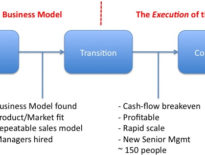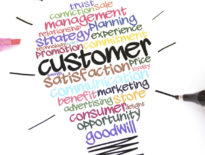
Every entrepreneur struggles with the idea of traction.
The word we hear uttered by investors, mentioned by advisors, cited in blog posts, and the holy grail of entrepreneurship, traction, really means a lot of different things to any number of people. And still, as we venture forth, we’re constantly focused on customers and what I’ve noticed as a frequently involved startup advisor is that most founders really have no idea who their customers might be.
What is Traction?
I’ve recently had a few experiences getting to know HOW to know customers. But before we go there, let’s clarify this oft asked question. What does traction mean when I’m being advised to get it?? Is it really only about customers (and how can it be when we’re early stage in our startup and not yet sure about who might fill that distinct role?)?
What I’ve experienced in working closely with investors is that the advice that you focus on revenue / customers can mean a few different things; often, it’s a soft “no.” For example:
- You’re not fundable, focus on customers
- I don’t get it, but I’m not willing to say that, get more input from customers
- I get it but you’re not listening to me, go talk to more customers
- I don’t think this is viable, but what do I know, get input from more customers
See, we get led to believe that customers are most important because a significant source (and often seemingly critical) of capital keeps telling us that we need them.
Is revenue AN option to validate traction? Sure, of course, if you have a product or service that warrants getting customers at this stage.
For most entrepreneurs, our economy is perpetuating the idea that startups should have customers and it’s causing founders to prioritize and listen to customers too soon.
Customers can mislead. Revenue disrupts focus. Heck, if/when you have revenue, you have less need for venture capital.
Don’t misunderstand me, some startups should be chasing customers and revenue early. Many should not be! And investors being too uncertain or inexperienced, with no confidence, to simply say, “no thank you,” are not helping.
What is other (often more significant) evidence of traction?
- Press coverage
- Attracting an amazing team
- Early investment or notable investors
- Notable advisors
- Partners
- Distribution channels
- Clear and validated business metrics
Traction means you have something worth consideration and in innovation (when you are inventing something anew) usually that shouldn’t mean customers.
Capisce? But how do we start figuring out what to do to serve customers?? How do we shift from market validation (what should really be your first step, not customer validation) to customer development?
Get To Know Your Potential Customers
In the earliest days of your work, it’s critical that you validate a market before validating customers. Is there an opportunity to run a business?
Study competitors, history, potential partners, costs, revenue models, what potential customers think they want – and what they might actually want.
The challenge at this stage is that customers often don’t know what they want. They can’t know how best to serve something new in a market where alternatives haven’t been sufficient. Having studied the market, the best next step is to model your potential customers’ journey.
Reagan Pugh, founder of Assemble and Director in Impact Hub’s Workforce Development Accelerator, recently shared with the Austin cohort in which MediaTech Ventures is involved, an exceptional process of customer discovery: the Customer Journey.
 I’ve spent a good couple days now mapping various journeys I’d like our customers in MediaTech to take. Reagan shared an ideal set of steps to take, and I encourage you to reach out to him to learn more since Customer Journey development is a process, but as I know you’re entrepreneurial spirit has you chomping at the bit to try some of this on your own, check out this list of resources Molly Galetto put together for NGDATA.
I’ve spent a good couple days now mapping various journeys I’d like our customers in MediaTech to take. Reagan shared an ideal set of steps to take, and I encourage you to reach out to him to learn more since Customer Journey development is a process, but as I know you’re entrepreneurial spirit has you chomping at the bit to try some of this on your own, check out this list of resources Molly Galetto put together for NGDATA.
It was during this process in the Accelerator, that KeyUp founder Adam Chasen noted that every journey begins with a profile.
Begging the question, how do we best develop customer profiles?
Start with demographics. Don’t think, just answer some basic questions as we can presume some things about your likely customer. The trick is to focus on your TARGET. To develop customer journeys and help direct the course of your venture, you can’t move forward with everyone in mind – even if technically everyone could be a customer. Who is the likely decision maker?
- How old?
- Male/female?
- Where do they live?
Now, what do they do for a living??
- Job title?
- Who is their boss?
- To which events they go?
- Where do they likely spend their time?
- On which social media are they likely interacting?
- Which brands they love?
Now we’re starting to see someone!
B2B Marketer Andrei Zinkevich and founder of GetLeado put together a great roadmap for your profiles in a question I posed to Quora.
#1 – Select your specific market segment
This step is the most common mistake companies make when working on ideal buyer persona. They select customers from different market segments and try to create a universal customer profile
Customers from different markets have different reasons for buying and using your product.
#2 – Find 10 likely customers from those market segments
The most common and the biggest mistake Andrei sees is that companies don’t devote time to the customers who will drive the most revenue.
The same focus and investment needs to be made toward your lead generation – when we’re ready.
Our goal is to generate more leads like these clients.
#3 – Fill your ideal client profile template
To do that, he suggests analyzing their social media profiles, interviewing them, and he offers this template to fill out…
If some data is missed, you can collect it during the next steps.
He’s further developed an ideal customer profile template which you can download here
#4 – Gather additional information from social media
If you can’t find your clients by first name, last name, and company search, you can drop their emails in a CSV file and upload them on LinkedIn.
Go to My Network –> More Options –> Upload file and upload a file with contacts of your customers.
LinkedIn will show you their profiles.
Now you can manually analyze every client profile and collect the necessary data.
Besides the basic information about their job, age, sex, and location, Andrei recommends looking to websites where your customers share their profiles.
In what communities might you find them?
#5 – Interview them
This is the most important step!
In previous 4 steps, we collected the basic information which can help us understand better who is our target ?ustomer and where we can find him.
In this step, our goal is to talk to our key customers and learn:
- what leads them to buy products like yours?
- what factors influence their purchasing decision?
- what are their current challenges that are related to your business?
- what are the problems your product solves for them?
- what might happen if these problems won’t be solved?
- why did they choose your company?
- what they love most about your product?
- are they satisfied with everything (quality, service, support, results, etc) or something can be improved?
- what features they’d like to see in your product?
- can they give you a testimonial or recommend your company?
- what social media do they regularly use?
- which industry blogs, websites or influencers are they following?
- who is also involved in their negotiation process or with whom they consult before buying products like yours?
“Never brainstorm it, just call and interview your core customers.”
This process is how you design and improve your product, generate referrals, improve your unique selling proposition, and personalize marketing materials.
#6 – Define ideal customer profile from existing data
The last step is to analyze all the data you’ve collected from your 10 best customers from the specific market segment and create a the ideal customer profile.
When it comes to points like doubts and objections, target resources, reasons why they buy your product, you should put here as maximum information as possible.
This profile is critical to every next step you take as a venture. Reach out to Andrei, Reagan, and Adam, or other customer profiling professionals, with questions. From this profile, you can better discern the journey your customers are likely to take from their first introduction to what you’re doing (how they become aware: awareness) to how they’re influenced, how they engage, why they buy, and who decides to become a customer of yours.



“Heck, if/when you have revenue, you have less need for venture capital.”
When you’re used to getting ten times the results using one third the resources.
Thanks for mentioning me, Paul. Glad you’ve enjoyed the process.
Your point around chasing revenue/customers too soon is, in my experience, spot on. As a founder of an early stage startup, we heard investors tell us to chase revenue, which lead us to making poor decisions for the product. One investor took us on a 6 month path to focus revenue that cause us to lose focus of building our product and business. This lead to a series of unfortunate events and the investor never investing.
Thanks for the insight.
Customer identification and segmentation can now be done anonymously (at least for b2b) on a scientific basis using some of the latest machine learning techniques. Surprisingly, at least for me, some of these techniques developed for marketing analytics here could be used for online / cybersecurity. For e.g. in behavioral modeling. Interesting stuff.